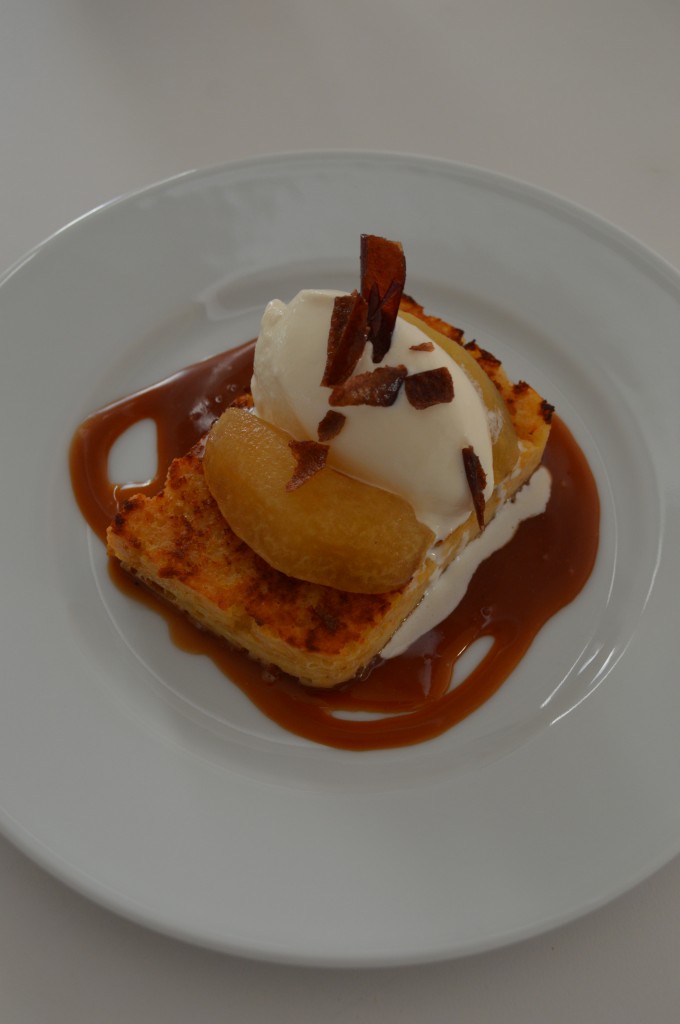 In the extremely unlikely case that you have leftover cornbread that is a couple days old and a bit too dry to be enjoyed, you have two choices.
In the extremely unlikely case that you have leftover cornbread that is a couple days old and a bit too dry to be enjoyed, you have two choices.
Look deep into the tepid pond of your soul and ask, sweet or savoury?
If the response comes back sweet, you make cornbread pudding. If the answer is savoury, you make cornbread stuffing.
Leftover cornbread and the dishes made therefrom are quite different than stale bread and its children. As cornbread is a quick bread, the baker went out of his or her way to avoid gluten development, and no doubt added sugar and fat in the form of butter or buttermilk or sour cream. This kept the fresh cornbread tender, but it now makes the dried cornbread extremely crumbly.
In my post about traditional stuffing I discuss a textural continuum. On one end is the loosely-bound style in which the individual bread pieces tumble over each other, and on the other is the highly-bound style in which the bread is moistened and mixed into a cohesive paste. Cornbread stuffing is always highly bound, because as soon as you drop the bread into the pot, it disintegrates into a very fine meal. In fact to make cornbread stuffing is almost like reverting the cornbread back to its elemental cornmeal, and then remaking it. Think of it as a phoenician rebirth.[1]
Moisture in the from of milk or stock, in conjunction with eggs, helps reform the crumbs into a cohesive, sliceable dressing.
The stuffing is very close to the original bread, only a bit more moist, and a bit eggier, but with the same characteristic granular texture.
Cornbread Stuffing
Ingredients
- 2 oz unsalted butter
- 7 oz sliced onions
- 5 oz sliced red bell peppers
- 1 tsp kosher salt
- 1/2 tsp dried summer savoury
- 1/2 tsp dried thyme
- 1 tsp paprika
- 20 oz stale cornbread (preferably this cornbread)
- 4 oz smoked pork stock (or any type of stock, really…)
- 3 large eggs
Procedure
- Melt the butter in a medium, heavy-bottomed stainless steel pot. Add the onion, peppers, salt, herbs and spices. Sweat over medium heat until the onions and peppers have become limp.
- Crumble the stale cornbread into the pot. Add the stock and mix until the cornbread starts to come together.
- Remove the mixture from the heat and let cool briefly. Beat in the eggs.
- Transfer the mixture to a buttered casserole and bake at 375°F until the interior has set. If the top is not quite crusty enough, give the casserole a pass under the broiler.
For cornbread pudding, forgo the onions, peppers, herbs, and spices; replace the stock with cream or milk; add a handful of sugar.
Cornbread Pudding
Ingredients
- 1 tsp kosher salt
- 2 oz granulated sugar
- 20 oz stale cornbread
- 4 oz heavy cream or whole milk
- 3 large eggs
Procedure
- Heat a pot of water on the stove.
- Whisk the eggs together.
- Crumble the stale cornbread into a large bowl. Add the cream and whisked eggs and mix until the cornbread starts to form a cohesive paste.
- Transfer the mixture to a buttered casserole or terrine. Set the dish into a large roasting tray. Pour the hot water from the stove into the roaster to make a hot bath for the casserole. Bake in a 350°F oven until the interior of the pudding has just set.
- Once cool, the pudding is best served by slicing and pan-frying. Consume with poached apples, whisky caramel sauce, vanilla ice cream. And maybe reserve the peels from your apples and gently fry them until they’re crisp and crumble them on top. As below.
1. I started to write “phoenix-like,” but then “phoenician” came to mind. Perhaps “phoenician,” with no capitalization, can be used to mean “of or pertaining to a phoenix,” as in the mythical creature? Or can it only mean “of or pertaining to the ancient nation of Phoenicia”?
